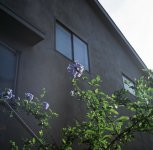Kodak's BW400CN film has an orange tint to the film base, designed to permit it to work best when being printed onto RA-4 paper in mini-lab machines.
If you try enlarging these negatives onto MG silver paper in your home darkroom, you won't be able to get good tones because the orange base acts as a severe contrast filter for the MG paper. Hence, Kodak's C-41 B/W film is not "amateur-friendly".
OTOH, Ilford's XP-2 Super, also a C-41 B/W film, has no orange tint to the film base, and prints nicely onto traditional silver paper.
You can tell which of these two companies understands the photo-enthusiast market, and which one doesn't.
~Joe
Post Script: In the future, try using the Ilford XP-2. But to salvage whatever images you've already exposed on the Kodak film, try using graded printing paper, which shouldn't be as color-sensitive to contrast as would MG paper. Select a medium-high contrast grade, maybe grade 3. Just guessing; I haven't done this with Kodak BW400CN. I prefer to give my money to the company that supports us amateurs.
Post-Post Script: I've studied Kodak's website over the years; they don't officially recognize the enthusiast amateur as even existing. It's either "pro" or "amateur" for film; amateur implying quick printing on minilabs, with dumbed-down color film that doesn't even have an ISO rating. They don't recognize that there is a potential customer base (who have subsequently given their business to others, like Ilford, Adox, Foma, et al) who are as sophisticated in technical knowledge as the "pro", but still prefers to print at home, but may want a mini-lab to process the film for them. Plenty of niche markets here that they've totally ignored. That, and in 2005 when they ended their B/W photo paper business.




















